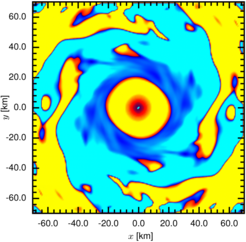What powers the explosion of stars?
Shedding light on the relationship between hypernova, supernova, and gamma-ray bursts
Enormous amounts of energy are released when a massive star, many times heavier than our Sun, collapses. Some stars explode in a hypernova - ten times more powerful than a normal supernova - and may emit a high-energy gamma-ray burst. Until now it was not clear how the extremely strong magnetic field needed for these processes is generated. A research team in the US, in cooperation with the Max Planck Institute for Gravitational Physics in Potsdam, now published an elaborate three-dimensional computer simulation, which sheds light on the relationship between hypernova, supernova, and gamma-ray bursts.

The research was led by Dr. Philipp Moesta (Caltech, now UBC) and Prof. Christian Ott (Caltech) whose team simulated the collapse of a star of six solar masses. Initially a just few kilometers large proto-neutron star is formed on which stellar matter continues to accrete. The core of the star rotates faster on its surface than in its interior, and thus neighbouring plasma layers rub against each other, eventually setting the plasma into turbulent motion. This "magnetorotational instability" largely enhances the existing magnetic field. Such a scenario has been suggested earlier, however, it could only be understood by the computer simulations now published in the journal Nature.
Fast software for huge amounts of data
Dr. Roland Haas, scientist in the "Astrophysical and Cosmological Relativity" division at AEI, co-developed the computer code for the simulation and optimized the visualization code. "It’s not only the energy of exploding stars that is very large, but also the amount of data that one needs to describe the complex process," explains Haas. To explore and understand the magnetic field structure the simulation data must be translated into images by a visualization software. "I have accelerated the visualization program by a factor of 60. Otherwise it could not have coped with the terabytes of data," says Haas.
Order out of chaos
The simulation shows that the magnetic field of the proto-neutron star is amplified in patches of only about one kilometer size. Initially the magnetic loops are not aligned with each other and are randomly oriented. For the first time ever, the authors of the study succeeded to simulate processes in stellar explosions to such a high resolution. Although the entire calculation covers an area of over one hundred kilometers, the just one kilometer large magnetic field is accurately depicted. Thus, the amplifying mechanism of magnetorotational instability is actually visible. Subsequently, a so-called dynamo process starts, leading to a large-scale magnetic field arranged perpendicular to the rotation axis. This large-scale magnetic field is able to confine stellar gas and push it out along the spin axis of the star. In this way, extremely energetic explosions - hypernovae and gamma-ray bursts - can be launched from the collapsed core.












